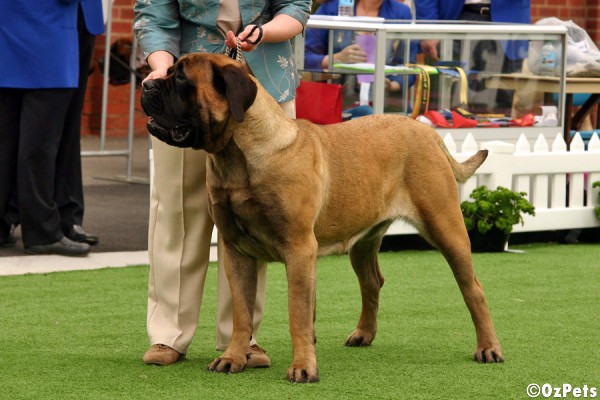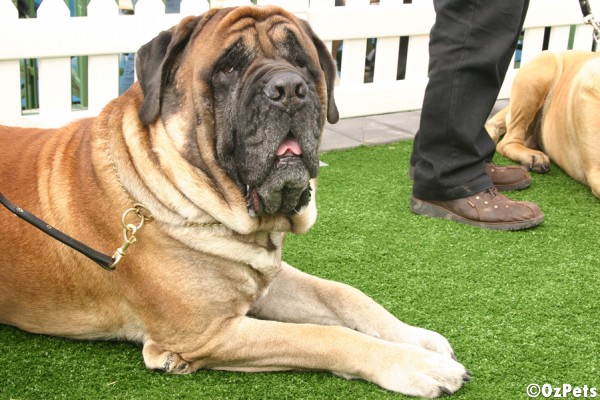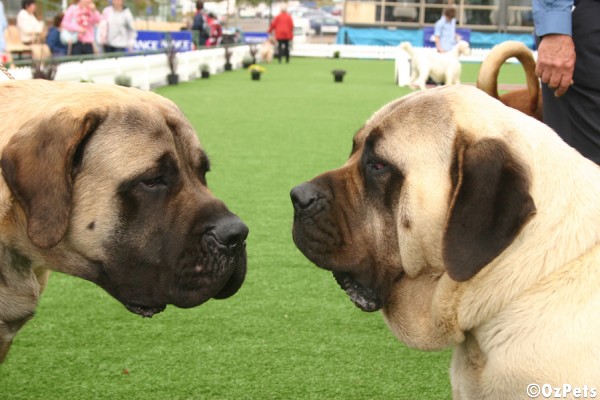
THE ENGLISH MASTIFF The English Mastiff is commonly referred to simply as the Mastiff. Distinguished by its enormous size, massive head, short coat in a limited range of colours, and always displaying a black mask, the Mastiff is noted for its gentle and loving nature. The lineage of modern dogs can be traced back to the early 19th century, but the modern type was stabilised in the 1880s and refined since. Following a period of sharp decline, the Mastiff has increased its worldwide popularity. Throughout its history the Mastiff has contributed to the development of a number of dog breeds, some generally known as mastiff-type dogs or, confusingly, just as "mastiffs".
The English Mastiff is commonly referred to simply as the Mastiff. Distinguished by its enormous size, massive head, short coat in a limited range of colours, and always displaying a black mask, the Mastiff is noted for its gentle and loving nature. The lineage of modern dogs can be traced back to the early 19th century, but the modern type was stabilised in the 1880s and refined since. Following a period of sharp decline, the Mastiff has increased its worldwide popularity. Throughout its history the Mastiff has contributed to the development of a number of dog breeds, some generally known as mastiff-type dogs or, confusingly, just as "mastiffs".
With a massive body, broad skull and head of generally square appearance, it is the largest living canine by weight, outweighing the wolf by up to 50 kg on average. A typical male can weigh 68-113 kg, a female 54-91 kg. It is on average slightly heavier than the Saint Bernard, although there is a considerable mass overlap between these two breeds. Though the Irish Wolfhound and Great Dane can be more than six inches taller, they are not nearly as robust. The colours of the Mastiff coat are differently described by various kennel clubs, but are essentially fawn or apricot, or those colours as a base for black brindle. A black mask should occur in all cases. The fawn is generally a light "silver" shade, but may range up to a golden yellow. The apricot may be a slightly reddish hue up to a deep, rich red. The brindle markings should ideally be heavy, even and clear stripes, but may actually be light, uneven, patchy, faint or muddled. Piebald Mastiffs occur rarely. Other non-standard colours include black, blue brindle, and chocolate (brown) mask. Some Mastiffs have a heavy shading caused by dark hairs throughout the coat or primarily on the back and shoulders. This is not generally considered a fault. Brindle is dominant over solid colour, other than black, which may no longer exist as a Mastiff colour. Apricot is dominant over fawn, though that dominance may be incomplete. Most of the colour faults are recessive, though black is so rare in the Mastiff that it has never been determined whether the allele is recessive or a mutation that is dominant.
The colours of the Mastiff coat are differently described by various kennel clubs, but are essentially fawn or apricot, or those colours as a base for black brindle. A black mask should occur in all cases. The fawn is generally a light "silver" shade, but may range up to a golden yellow. The apricot may be a slightly reddish hue up to a deep, rich red. The brindle markings should ideally be heavy, even and clear stripes, but may actually be light, uneven, patchy, faint or muddled. Piebald Mastiffs occur rarely. Other non-standard colours include black, blue brindle, and chocolate (brown) mask. Some Mastiffs have a heavy shading caused by dark hairs throughout the coat or primarily on the back and shoulders. This is not generally considered a fault. Brindle is dominant over solid colour, other than black, which may no longer exist as a Mastiff colour. Apricot is dominant over fawn, though that dominance may be incomplete. Most of the colour faults are recessive, though black is so rare in the Mastiff that it has never been determined whether the allele is recessive or a mutation that is dominant. At all stages of development, the Mastiff should show the breed characteristics of massiveness and sound, if cumbersome, movement. The Mastiff is a particularly large dog demanding correct diet and exercise. A Mastiff may be kept in an apartment, but care must be taken to give it enough exercise. Mastiffs require light but regular exercise and regular socialization with other dogs and people. Generally they have quite a soft nature despite their early origins and do not benefit from harsh training methods. They respond very well to basic obedience training, provided it is praise and reward type training. A soft surface is recommended for the dog to sleep on to prevent the development of calluses and arthritis. The average lifespan of the Mastiff is about 7 years, although it is not uncommon for some to live 10-11 years.
At all stages of development, the Mastiff should show the breed characteristics of massiveness and sound, if cumbersome, movement. The Mastiff is a particularly large dog demanding correct diet and exercise. A Mastiff may be kept in an apartment, but care must be taken to give it enough exercise. Mastiffs require light but regular exercise and regular socialization with other dogs and people. Generally they have quite a soft nature despite their early origins and do not benefit from harsh training methods. They respond very well to basic obedience training, provided it is praise and reward type training. A soft surface is recommended for the dog to sleep on to prevent the development of calluses and arthritis. The average lifespan of the Mastiff is about 7 years, although it is not uncommon for some to live 10-11 years.
Mastiffs are a superb and loyal companion. They are totally devoted to their owners and generally not aggressive toward strangers and strange dogs especially when they have had good grounding of early socialization. Mastiffs make a good family member and most mastiffs are generally get on well with children especially their own. Even so they should always be supervised especially around other peoples children. It is important for the good name and reputation of the breed that your mastiff is always under effective control in public. An important point to remember is mastiffs may often end up as a very large and expensive dog.